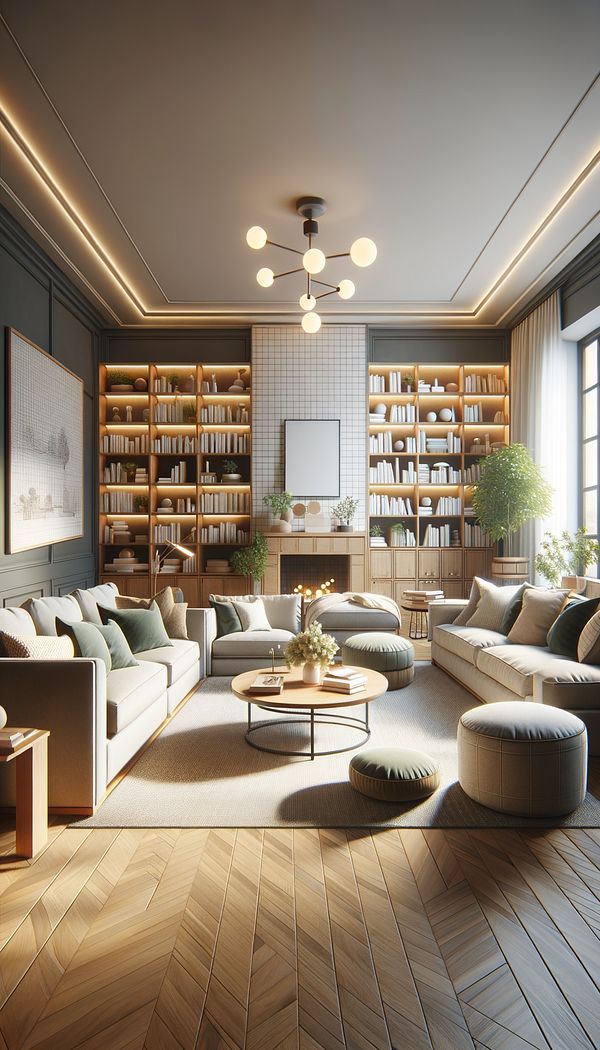What is Furniture Arrangement?
Furniture arrangement is the process of organizing and positioning furniture in a room to create a cohesive, functional, and aesthetically pleasing space.
Description
Furniture arrangement is a foundational aspect of interior design that focuses on the placement of furniture within a space to optimize functionality, comfort, and visual appeal. This involves considering the size and shape of the room, the type and quantity of furniture, and how the space will be used. Good furniture arrangement can enhance room flow, facilitate communication, create focal points, and even affect the perceived size of a room.
Furniture arrangement is not a one-size-fits-all task; it varies with each space and its intended use. It requires an understanding of design principles, such as balance, rhythm, and harmony, as well as an awareness of the specific needs and preferences of the users. For example, a living room might prioritize comfortable seating and entertainment areas, while a home office might focus on desk placement for optimal lighting and minimal distractions.
Furniture arrangement also takes into account the placement of rugs, lighting fixtures, and other decorative elements. These elements work together to create a cohesive and inviting atmosphere. Additionally, incorporating elements of accessibility and ergonomics ensures that the space is comfortable and usable for all individuals.
Usage
In a small living room, furniture arrangement might prioritize a clear pathway between the entrance and seating area, using smaller-scale furniture and positioning it to encourage conversation and maintain an open feel. In a large bedroom, furniture arrangement could involve creating distinct areas for sleeping, dressing, and lounging, guiding the room's flow with a central rug or a strategically placed divider.
FAQs
-
What are the basic principles of furniture arrangement?
The basic principles include balance, which ensures that no single part of the room overpowers another; focal point creation, which draws attention to a certain area or piece; and flow, which facilitates easy movement. Considering scale and proportion is also crucial to ensure the furniture fits comfortably within the space.
-
How does furniture arrangement impact room functionality?
Furniture arrangement directly impacts how a room is used and navigated. Properly arranged furniture can define different functional areas within a room, enhance comfort by facilitating ease of movement and interaction, and even influence the room's acoustics and lighting.
-
Can furniture arrangement affect the perceived size of a room?
Yes, strategic furniture arrangement can make a room appear larger or cozier depending on the placement and scale of furniture. For instance, pushing furniture against the walls can create a sense of spaciousness, while grouping pieces closer together can create a cozy, intimate setting.
Practical Application
When arranging furniture, start by identifying the room's focal point and arranging furniture in a way that complements it. Prioritize the functionality of the space, considering how it will be used and by whom. Measure your space and furniture to ensure fit and maintain an open pathway for traffic flow. Remember, furniture arrangement is reversible and adjustable, so feel free to experiment until you find the best setup for your needs.
-
Furniture Types599 articles
-
Space Planning & Layout134 articles
-
Lighting Fixtures & Hardware17 articles
-
Decorating Principles & Elements330 articles
-
Accessibility & Ergonomics30 articles
-
Drop-In SeatA drop-in seat is a type of chair seat that is easily removable and replaceable.
-
Stereo CabinetA furniture piece designed to house and display stereo equipment and media.
-
Arts & CraftsArts & Crafts refers to both an interior design style and a movement prioritizing handcrafted, simple forms often inspired by nature.
-
Tavern TableA Tavern Table is a type of small, typically rectangular or circular table, historically used in taverns.
-
Builder, HomeIn the context of interior design, home builder refers to a person or company specializing in constructing residential homes.
